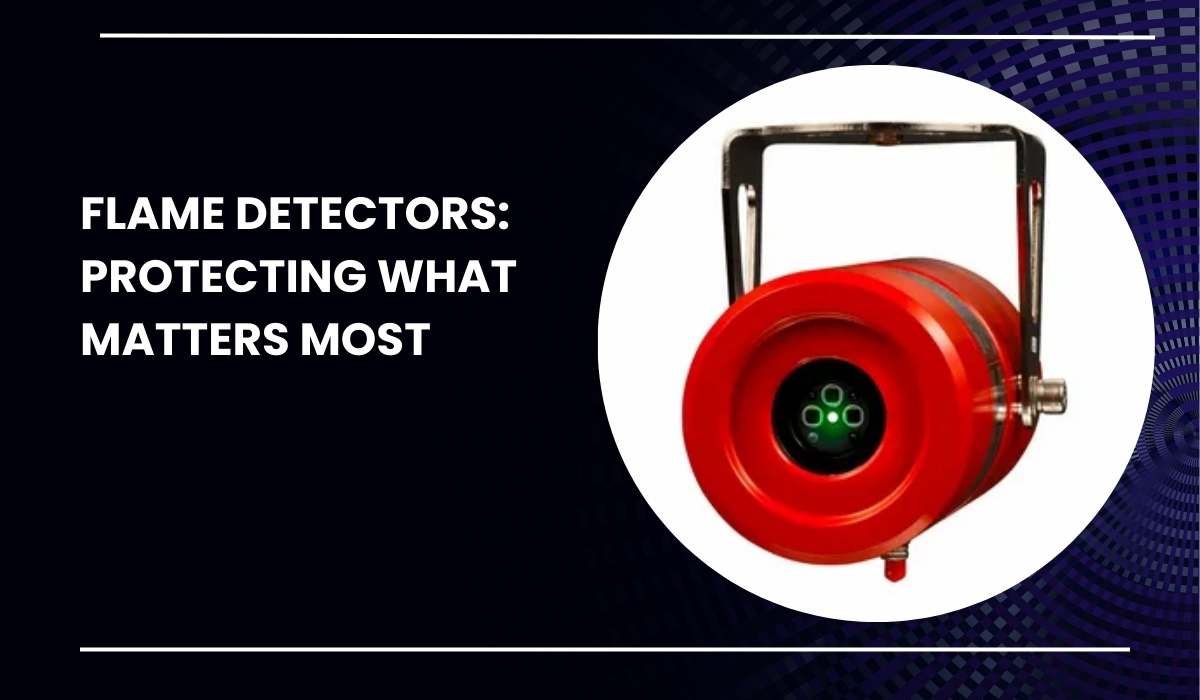In today’s world, ensuring safety in homes, businesses, and industries is of utmost importance. One of the most effective ways to safeguard lives and property from fire hazards is through the use of flame detectors. These devices are not just technical instruments; they are silent sentinels that stand guard against potential disasters. But what exactly are flame detector? How do they work, and why are they essential? This article delves deep into these questions to provide you with a clear understanding of flame detectors, their importance, and how they can make a difference in safeguarding your environment.
What is a Flame Detector?
A flame detector is a sensor designed to detect and respond to the presence of flames or fire. Unlike smoke detectors that rely on detecting particles or heat detectors that sense rising temperatures, flame detectors identify the specific wavelengths of light produced by a flame. This makes them incredibly fast and reliable, especially in high-risk environments where every second counts.
Key Features of Flame Detectors:
- High sensitivity to flames
- Fast response time
- Ability to operate in challenging conditions
- Compatibility with alarm systems and fire suppression mechanisms
- Detection of various flame types, including invisible flames from certain fuels

How Do Flame Detectors Work?
Flame detectors utilize optical sensors to monitor for the presence of ultraviolet (UV) or infrared (IR) light. When a flame is present, it emits specific wavelengths of light, which the detector recognizes and processes to trigger an alarm. Depending on the type of flame detector, they may use one or a combination of UV, IR, or visible light detection technologies.
Types of Flame Detectors:
1. Ultraviolet (UV) Flame Detectors
UV flame detectors detect ultraviolet radiation emitted by flames. They are highly effective in detecting fast-burning fires but are sensitive to false alarms caused by sunlight or welding.
2. Infrared (IR) Flame Detectors
IR flame detectors identify infrared radiation, which is emitted as heat by a flame. These detectors are suitable for environments with minimal false alarm triggers but may struggle with smoke obstructions.
3. UV/IR Combination Flame Detectors
Combining UV and IR technologies, these detectors offer enhanced accuracy by reducing false alarms. They are often used in industrial settings for detecting hydrocarbon-based fires.
4. Multi-Spectrum IR Detectors
Using multiple IR sensors, these detectors can differentiate between real flames and other heat sources. They are highly reliable in detecting hydrocarbon and non-hydrocarbon fires.
5. Visual Flame Detectors
These detectors use cameras to identify the visible spectrum of flames. They provide real-time footage, making them ideal for monitoring large areas.
Comparison of Flame Detector Types
| Type | Sensitivity | False Alarm Resistance | Applications |
|---|---|---|---|
| UV Detectors | High | Moderate | Explosive areas, aviation |
| IR Detectors | Moderate | High | Oil and gas, manufacturing |
| UV/IR Detectors | High | Very High | Chemical plants, warehouses |
| Multi-Spectrum IR | Very High | Extremely High | Refineries, offshore platforms |
| Visual Detectors | Moderate | High | Power plants, large facilities |
Applications of Flame Detectors
Flame detectors are indispensable across various sectors. Their ability to provide early warnings and activate safety systems can prevent catastrophic losses. Below are some of the most common applications:
1. Industrial Plants
Industrial settings, such as oil refineries, chemical plants, and manufacturing units, are prone to fires. Flame detectors ensure timely detection and allow for quick action, reducing risks to workers and property.
2. Warehouses
With highly flammable materials often stored in warehouses, flame detectors act as a first line of defense to mitigate potential fire outbreaks.
3. Transportation Hubs
Airports and shipyards require robust safety systems to handle fuel and flammable materials. Flame detectors are crucial in preventing disasters in such high-risk zones.
4. Residential Buildings
Advanced flame detectors are now being integrated into smart home systems to provide better fire safety solutions for homes.
5. Power Plants
Power generation facilities often operate in extreme conditions where flame detection systems ensure uninterrupted and safe operations.
Also Read:-https://www.atoallinks.com/2024/flame-detectors-a-complete-guide-to-fire-safety-innovation/
Advantages of Flame Detectors
- Speed and Accuracy: Flame detectors respond faster than traditional smoke and heat detectors.
- Reduced False Alarms: Modern flame detectors use advanced technologies to distinguish between real flames and other sources of light or heat.
- Durability: Designed to withstand harsh environments, they are suitable for indoor and outdoor use.
- Integration with Safety Systems: Flame detectors can be integrated with alarm systems, sprinklers, and other fire suppression systems.
- Versatility: They detect various types of flames, including invisible flames from certain fuels.
Benefits of Flame Detectors
| Benefit | Description |
| Speed | Rapid detection and response |
| Accuracy | Precise identification of flames |
| Durability | Operates in harsh environmental conditions |
| Integration | Compatible with alarm and suppression systems |
| Versatility | Detects multiple flame types |
Challenges and Limitations
While flame detectors are highly effective, they come with certain limitations that users should be aware of:
- False Alarms: Despite advanced features, certain conditions like welding or bright sunlight can trigger false alarms in UV detectors.
- Cost: High-quality flame detectors can be expensive, making them less accessible for smaller businesses or households.
- Maintenance: Regular maintenance and calibration are required to ensure their accuracy and reliability.
- Limited Smoke Detection: Flame detectors do not detect smoke, which might delay response in smoldering fires.
- Obstructions: Smoke, dust, or physical barriers can affect the detector’s performance.

Choosing the Right Flame Detector
Selecting the appropriate flame detector depends on various factors such as the type of environment, potential fire hazards, and budget constraints. Here are some tips to help you make an informed choice:
- Identify Fire Risks: Understand the types of fires likely to occur in your environment.
- Evaluate Environmental Conditions: Consider factors like temperature, humidity, and potential obstructions.
- Check Compatibility: Ensure the flame detector integrates well with existing safety systems.
- Consider Maintenance Needs: Choose detectors that are easy to maintain and calibrate.
- Consult Experts: Engage fire safety professionals for recommendations and installation.
The Future of Flame Detection Technology
With advancements in technology, flame detectors are becoming smarter and more efficient. Artificial intelligence (AI) and machine learning are being integrated to enhance their accuracy and predictive capabilities. Wireless connectivity and IoT integration are also transforming flame detectors into more versatile and accessible devices.
Imagine a future where flame detectors not only alert you to a fire but also provide real-time data analytics, predict fire patterns, and automatically activate safety protocols. This vision is closer to reality than ever, promising safer environments for everyone.
Conclusion
Flame detectors play a pivotal role in fire safety, offering unparalleled speed and accuracy in detecting flames. Whether in industrial plants, warehouses, or residential buildings, these devices are indispensable for protecting lives and assets. By understanding their types, applications, benefits, and limitations, you can make informed decisions to enhance fire safety in your environment. As technology continues to evolve, the capabilities of flame detectors will only improve, making them an even more valuable asset in the fight against fire hazards.
For More Insightful Articles Related To This Topic, Feel Free To Visit: kyalu.
Also Read
- ► Ok Win Register Bonuses – Start Your Gaming Journey with a Boost
- ► The Growing Trend of Pet Grooming in Bangalore: Why It’s Essential for Your Dog’s Health and Well-being
- ► Where Do Production Studios Get Old Cars for Filming Movies?
- ► Tips for Designing an Efficient L Shaped Modular Kitchen
- ► How to Improve Academic Performance Instantly
- ► High-Quality WWE Championship Belts
- ► Why Use Google Adsense?
- ► The Importance of Time Management in Academic Success
- ► Reliable International Shipping with iPlanet Courier
- ► Corporate Van Service NJ NY & Efficient and Reliable Group Transportation
- ► Smart Money Tips from Tevan Asaturi
- ► Best Digital Marketing Training Institute In Noida
- ► Indian Visa for Kazakhstani Citizens
- ► Fear of god Essentials hoodie Shop And Tracksuit
- ► SBI Long Term Equity Fund: A Secret To Wealth Creation





